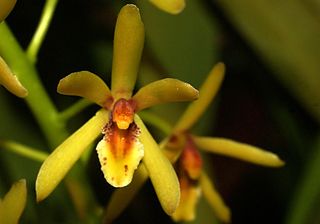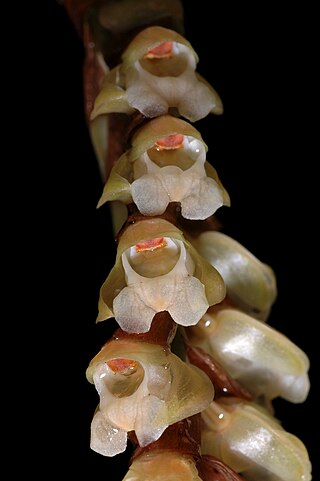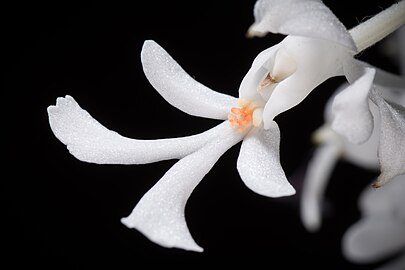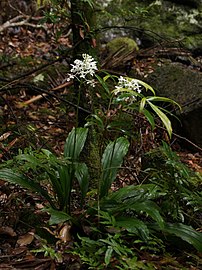
Cymbidium suave, commonly known as the snake orchid or grassy boat-lip orchid, is a plant in the orchid family and is endemic to eastern Australia. It is an epiphytic orchid that forms long-lasting clumps of grass-like leaves. Up to fifty crowded olive green to dark or brownish green flowers are borne on an arching flowering stem. Of the three Australian species of Cymbidium, this is the only one that does not have prominent pseudobulbs. It is found in eastern Australia, usually growing in the hollows of old or fallen, decaying trees.

Acriopsis emarginata, commonly known as the pale chandelier orchid, is a species of orchid endemic to Queensland. It is a clump-forming epiphyte with dark green leaves and curved, branching flower stems with many white and cream-coloured flowers.

Dendrobium wassellii, commonly known as the furrowed pencil orchid, is a species of orchid endemic to a small area on Cape York Peninsula. It is an epiphytic or lithophytic orchid with branched stems, cylindrical, furrowed leaves and flowering stems with up to sixty crowded white flowers with a yellow labellum.

Cymbidium madidum, commonly known as the giant boat-lip orchid, is a plant in the orchid family and is endemic to north-eastern Australia. It is a clump-forming epiphyte or lithophyte with crowded pseudobulbs, each with between four and eight flat, strap-shaped, thin leaves and up to seventy olive green flowers with the sepals and petals curving forwards. It is found in moist habitats in eastern Queensland and north-eastern New South Wales.

Cymbidium canaliculatum, commonly known as the channelled boat-lip orchid, tiger boat-lip orchid, native cymbidium or tiger orchid is a plant in the orchid family and is endemic to Australia. It is a clump-forming epiphyte with large, greyish green pseudobulbs, each with up to six curved, deeply channelled leaves and up to sixty fragrant, variably coloured flowers that often have spots and blotches and a white to cream-coloured labellum with red markings. This orchid usually grows in the forks or hollows of trees and is found from New South Wales to the northern parts of Western Australia.

Dendrobium gracilicaule, commonly known as the blotched cane orchid or yellow cane orchid, is an epiphytic or lithophytic orchid in the family Orchidaceae. It has cylindrical pseudobulbs, between three and seven thin leaves and up to thirty often drooping, cream-coloured to yellow or greenish flowers, sometimes with reddish brown blotches on the back. There are two varieties, one occurring in Queensland and New South Wales and the other on some Pacific Islands, including Lord Howe Island.

Dendrobium jonesii, commonly known as the oak orchid is a species of epiphytic or lithophytic orchid endemic to far north Queensland. It has spindle-shaped pseudobulbs, up to seven thin, dark green leaves and up to thirty five crowded, star-like, fragrant cream-coloured or white flowers with purple markings on the labellum.
Bulbophyllum macphersonii, commonly known as eyelash orchids, is a species of epiphytic or lithophytic orchid that is endemic to Queensland. It has tiny, crowded, slightly flattened, dark green pseudobulbs, a single thick, fleshy leaf and a single dark red to purplish red flower with a narrow labellum. It grows on trees and rocks in sheltered places.

Phaius tankervilleaevar.australis, also known as the common swamp orchid, southern swamp-orchid, swamp lily or island swamp-orchid, is a species of orchid endemic to eastern Australia. It is an evergreen, terrestrial herb with large, crowded pseudobulbs, large pleated leaves and flowers that are reddish brown on the inside and white outside.

Spathoglottis paulinae, commonly known as the small purple orchid, is a plant in the orchid family and is native to New Guinea and Tropical North Queensland. It is an evergreen terrestrial orchid with crowded pseudobulbs, between four and seven large, pleated leaves and up to thirty mauve to purple flowers.

Dendrobium falcorostrum, commonly known as the beech orchid, is a species of epiphytic orchid endemic to eastern Australia. It has spindle-shaped pseudobulbs, each with between two and five leathery leaves and up to twenty crowded white flowers with purple markings on the labellum.
Liparis nugentiae, commonly known as the large sphinx orchid, is a plant in the orchid family and is endemic to Queensland. It is an epiphytic or lithophytic orchid which forms clumps with flattened pseudobulbs, two to four thin leaves and up to twenty greenish or pale yellow flowers. It grows in rainforest at altitudes above 600 m (2,000 ft) in tropical far North Queensland.
Tainia trinervis, commonly known as the ribbon orchid, is an evergreen, terrestrial plant with crowded pseudobulbs, each with a single smooth, shiny leaf and up to fourteen greenish to yellowish flowers with red or purplish stripes in the middle. It is found in tropical Southeast Asia, New Guinea and northern Australia.
Dendrobium schneiderae, commonly known as the Eungella moon orchid or small moon orchid, is an epiphytic orchid in the family Orchidaceae and is endemic to eastern Australia. It has crowded pseudobulbs with two leaves on the tip of each and arching flowering stems with up to thirty five waxy, yellowish, cup-shaped flowers. It grows in open forest and rainforest.
Dendrobium eungellensis, is an epiphytic orchid in the family Orchidaceae and is endemic to northern Queensland. It has dark greenish brown pseudobulbs with up to three leaves on the end and up to eight fragrant white flowers with thin, spreading sepals and petals. It grows in open forest in the Eungella National Park.

Dendrobium malbrownii, commonly known as the McIlwraith hermit orchid, is an epiphytic or lithophytic orchid in the family Orchidaceae and is endemic to tropical North Queensland, Australia. It has thin, wiry, crowded stems each with narrow, dark green leaves and a single shiny, cream-coloured flower with a purple labellum. It grows on trees, fallen logs and rocks in rainforest on the McIlwraith Range.
Dendrobium neospectabile, commonly known as the Eungella king orchid, is a species of epiphytic or lithophytic orchid that is endemic to tropical North Queensland. It has cylindrical, yellowish green pseudobulbs, up to three thick, leathery leaves and up to two hundred and fifty crowded cream-coloured to pale yellow flowers with reddish purple streaks on the labellum.
Dendrobium deuteroeburneum, commonly known as the rainforest feather orchid, is a species of epiphytic or lithophytic orchid that is endemic to eastern Australia. Its pseudobulbs are cylindrical, pressed against the host tree or rock and have one or two leathery, dark green leaves and up to seven pale greenish cream-coloured flowers with purple markings on the labellum.

Liparis condylobulbon, commonly known as the tapered sphinx orchid or 细茎羊耳蒜 is a plant in the orchid family. It is an epiphytic or lithophytic orchid with crowded, glossy green, cylinder-shaped pseudobulbs, each with two linear to lance-shaped leaves and between fifteen and thirty five pale green to cream-coloured flowers with an orange labellum. This orchid usually grows on trees and rocks in rainforest from Taiwan and Indochina to the south-west Pacific.

Pholidota imbricata, commonly known as the common rattlesnake orchid or necklace orchid, is a plant in the orchid family and is a clump-forming epiphyte or lithophyte with crowded pseudobulbs. Each pseudobulb has a single pleated, leathery leaf and up to sixty white, cream-coloured or greenish, cup-shaped flowers in two ranks along a wiry flowering stem. There is a large, papery bract at the base of each flower. This species is native to areas from tropical and subtropical Asia to the southwest Pacific.

















